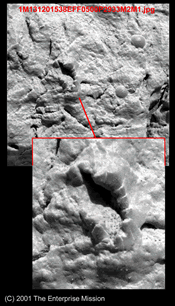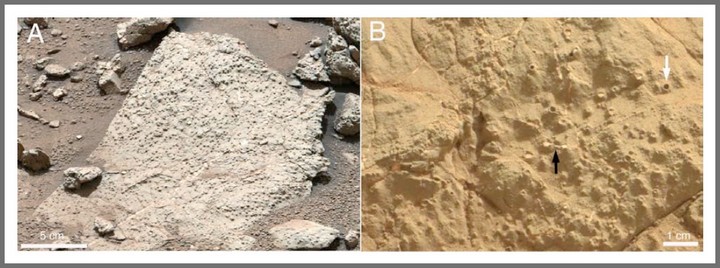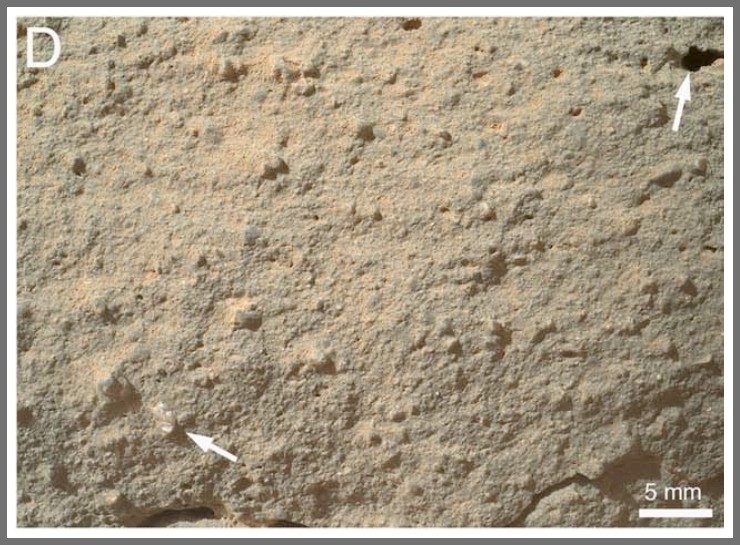It looks like you're using an Ad Blocker.
Please white-list or disable AboveTopSecret.com in your ad-blocking tool.
Thank you.
Some features of ATS will be disabled while you continue to use an ad-blocker.
share:
super70
reply to post by yorkshirelad
Haven't seen that one yet, good find!
Here you go:
www.enterprisemission.com...
This was found by Opportunity, and Richard Hoagland, in 2004, very soon after Opportunity landed.
A close-up enlargement of this fascinating object (above – bottom), reveals an apparently "snapped off" body geometry, at least five visible cylindrical "segments," and a hint of other fossil-like features buried in the surrounding rock itself – all classic hallmarks of a former living organism!
So, what did the JPL Rover science Team do with this potentially explosive scientific find …?
They promptly ground it into powder … right before our eyes (PanCAm color image, below)!

edit on 20-1-2014 by Aleister because: (no reason given)
edit on 20-1-2014 by Aleister because: (no reason
given)
edit on 20-1-2014 by Aleister because: (no reason given)
super70
reply to post by Aleister
While this possible theory could explain the conical shaped crinoid holdfast and prasopora claims, it does not explain the crinoid stem fossils. The fact that they are in close proximaty to the cones (like you might find on a shoreline on earth) makes the case for fossila, rather than tiny mud volcanoes.
I see the conical hold fasts I think. They all have a red line pointing to them. But I do not see the crinoid stems... unless...are some of those "holdfasts" not quite conical and these are what you are calling the stems? So it is not really a stem but just one "increment" of a stem? If I'm guessing correctly on what the stem is, it's the uh stem-like structures with usually multiple incremental units. I dunno, maybe I need to take another look at the image... Every fossil has a red line right?
Mamatus
Personally I have never wondered if life once existed on Mars. I think the topography of Mars (and your find) completely support that life of some type once existed. Even scientists think life once existed there.
What I am even more curious about is what happened to the atmosphere of Mars?
Fukushima.....but....you know....on Mars
Call me crazy.....but I'm curious. Wouldn't fossils on another planet be totally different than anything we'd find here on earth? That they are
the same would have to be accounted for? Don't get me wrong, I think the OP has a fantastic find! But seriously...what odds would a vegas bookie
have given? It seems puzzling.
reply to post by super70
Another piece of evidence of past life on Mars...
This is big.
S&F.
NASA: what are you waiting?
Another piece of evidence of past life on Mars...
This is big.
S&F.
NASA: what are you waiting?
This is the most convincing "past life on mars" pics I have seen.
Although the russians showed us there are massive heated underground structures on mars, and something very long hanging around phobos.
This may just go down in the books as the first accepted discovery of such on mars or anywhere.
And its definitely in a ancient bay, so it fits nicely.
I would send NASA an email and lay claim to this discovery before someone else beats you to the punch.
We will probably see this on the MSM all things equal.
They would happily admit to this, but not complex intelligent life - we ain't ready for that one, apparently.
And in regards to the poster who asked about the chances of identical life being found on the next planet over ?
Pretty likely if you ask me! Panspermia directed or otherwise.
Although the russians showed us there are massive heated underground structures on mars, and something very long hanging around phobos.
This may just go down in the books as the first accepted discovery of such on mars or anywhere.
And its definitely in a ancient bay, so it fits nicely.
I would send NASA an email and lay claim to this discovery before someone else beats you to the punch.
We will probably see this on the MSM all things equal.
They would happily admit to this, but not complex intelligent life - we ain't ready for that one, apparently.
And in regards to the poster who asked about the chances of identical life being found on the next planet over ?
Pretty likely if you ask me! Panspermia directed or otherwise.
reply to post by super70
I was wondering whether the NASA/JPL team looked into this and found the following excerpt in a research paper by J. Grotzinger, in which they briefly talk about similar features (but I'm not sure that this is exactly the same thing).
A Habitable Fluvio: Lacustrine Environment at Yellowknife Bay, Page 29 (source):


The image above (right) is taken from another rock close to the find of the OP. Although there may well be differences in size and shape of the potential crinoid holdfasts, NASA/JPL apparently describe these rings by referring to vuggy porosity. So they more or less think it's a geological/geochemical process.
But I'm not sure: I also see some differences and the OP's resemblance with crinoid holdfasts is striking. Besides, it's not the same rock and the features they refer to are 'similar', at best. I think we still need some more expertise here to see whether or not these might be fossilized biological features ...
Link to research paper (page 29):
authors.library.caltech.edu...
I was wondering whether the NASA/JPL team looked into this and found the following excerpt in a research paper by J. Grotzinger, in which they briefly talk about similar features (but I'm not sure that this is exactly the same thing).
A Habitable Fluvio: Lacustrine Environment at Yellowknife Bay, Page 29 (source):


The image above (right) is taken from another rock close to the find of the OP. Although there may well be differences in size and shape of the potential crinoid holdfasts, NASA/JPL apparently describe these rings by referring to vuggy porosity. So they more or less think it's a geological/geochemical process.
But I'm not sure: I also see some differences and the OP's resemblance with crinoid holdfasts is striking. Besides, it's not the same rock and the features they refer to are 'similar', at best. I think we still need some more expertise here to see whether or not these might be fossilized biological features ...
Link to research paper (page 29):
authors.library.caltech.edu...
edit on 21-1-2014 by jeep3r because: text
reply to post by jeep3r
Wikipedia describes vuggy porosity as possibly being made by macrofossils, the remains of organic material.
en.wikipedia.org...
So, if the experts and wiccans at Wikipedia are right, has NASA already quietly announced the very real possibility of discovering past life on Mars in the paper you quoted from and posted?
Wikipedia describes vuggy porosity as possibly being made by macrofossils, the remains of organic material.
en.wikipedia.org...
This is secondary porosity generated by dissolution of large features (such as macrofossils) in carbonate rocks leaving large holes, vugs, or even caves.
So, if the experts and wiccans at Wikipedia are right, has NASA already quietly announced the very real possibility of discovering past life on Mars in the paper you quoted from and posted?
jeep3r
reply to post by super70
I was wondering whether the NASA/JPL team looked into this and found the following excerpt in a research paper by J. Grotzinger, in which they briefly talk about similar features (but I'm not sure that this is exactly the same thing).
A Habitable Fluvio: Lacustrine Environment at Yellowknife Bay, Page 29 (source):
edit on 21-1-2014 by Aleister because: (no reason given)
edit on 21-1-2014 by Aleister because: (no reason
given)
edit on 21-1-2014 by Aleister because: (no reason given)
edit on 21-1-2014 by Aleister because: (no reason
given)
edit on 21-1-2014 by Aleister because: (no reason given)
reply to post by Aleister
Excellent contribution, Aleister, thanks for adding that info. Makes me think that NASA/JPL are deliberately being very or perhaps even 'overly' careful in phrasing their assumptions/theories. Or there are indeed certain restrictions in their information policy, as I previously outlined in other posts.
I'll certainly keep an eye on this topic and hope that others are also going to contribute with their expertise on the subject matter ...
Excellent contribution, Aleister, thanks for adding that info. Makes me think that NASA/JPL are deliberately being very or perhaps even 'overly' careful in phrasing their assumptions/theories. Or there are indeed certain restrictions in their information policy, as I previously outlined in other posts.
I'll certainly keep an eye on this topic and hope that others are also going to contribute with their expertise on the subject matter ...
edit
on 21-1-2014 by jeep3r because: text
reply to post by Aleister
I need to correct myself: the previous textbit was associated with another figure. Here's the correct NASA/JPL comment on the potential crinoid holdfasts or circular impressions, from page 30 in this publication:


NASA/JPL themselves do not seem to clearly state what these features could be, their wording is rather of descriptive than interpretative nature (circular cross-sections with raised rims etc.). Here's the link to the original Sol 159 MASTCAM image. Could these circumstances even raise the chances for this being something of biological origin ... ?
Link to research paper (pages 29-30):
authors.library.caltech.edu...
I need to correct myself: the previous textbit was associated with another figure. Here's the correct NASA/JPL comment on the potential crinoid holdfasts or circular impressions, from page 30 in this publication:


NASA/JPL themselves do not seem to clearly state what these features could be, their wording is rather of descriptive than interpretative nature (circular cross-sections with raised rims etc.). Here's the link to the original Sol 159 MASTCAM image. Could these circumstances even raise the chances for this being something of biological origin ... ?
Link to research paper (pages 29-30):
authors.library.caltech.edu...
edit on 21-1-2014 by jeep3r because: text
reply to post by jeep3r
jeep, you raise the hope of the world that NASA has covertly announced possible life on mars, and then you dash them on a mastcam.
Can you find the photo which the original caption was describing? Of all the rocks on all the worlds you had to walk into wine.
jeep, you raise the hope of the world that NASA has covertly announced possible life on mars, and then you dash them on a mastcam.
Can you find the photo which the original caption was describing? Of all the rocks on all the worlds you had to walk into wine.
reply to post by Caver78
I would think that the most simple forms of life, like the ones found in Earth's ancient lake beds and ocean floors would be similar wherever life begins. Once the evolution of the species becomes more complex and begins adapting to the conditions of its environment would it become different from those found on Earth. Organisms that evolved in icey conditions here become much different than their counterparts evolving in lush tropical environments, and these being the same species on the same planet.
I would think that the most simple forms of life, like the ones found in Earth's ancient lake beds and ocean floors would be similar wherever life begins. Once the evolution of the species becomes more complex and begins adapting to the conditions of its environment would it become different from those found on Earth. Organisms that evolved in icey conditions here become much different than their counterparts evolving in lush tropical environments, and these being the same species on the same planet.
reply to post by Soapusmaximus
Thanks. I did have one of my finds get picked up by all the MSM news, I'm the one who found the Monolith on Mars in 2009. Here is my original link if anyone is interested...
Monolith on Mars
I also agree with the concept of Panspermia. A large meteor strike on a life bearing planet is like someone sneezing in a crowded room. Millions of tiny life forms blown out drifting and settling on new hosts, each adapting and evolving to its new hosts environment.
Thanks. I did have one of my finds get picked up by all the MSM news, I'm the one who found the Monolith on Mars in 2009. Here is my original link if anyone is interested...
Monolith on Mars
I also agree with the concept of Panspermia. A large meteor strike on a life bearing planet is like someone sneezing in a crowded room. Millions of tiny life forms blown out drifting and settling on new hosts, each adapting and evolving to its new hosts environment.
Saw the title and thought it was actual confirmation of proof from the science community. Maybe next time.
reply to post by roadgravel
Unfortunately many people feel this way, waiting for the MSM to tell us something we all know to be true, in order to make it a bona fide fact.
My personal belief is that proof will come first from an amatuer, then the MSm will have no choice but to agree. Just my thoughts.
Unfortunately many people feel this way, waiting for the MSM to tell us something we all know to be true, in order to make it a bona fide fact.
My personal belief is that proof will come first from an amatuer, then the MSm will have no choice but to agree. Just my thoughts.
Aleister
reply to post by jeep3r
Can you find the photo which the original caption was describing? Of all the rocks on all the worlds you had to walk into wine.
Here goes the image to which the original caption referred, with 'glassy luster' (see lower left arrow) & a small amount of 'vuggy porosity' being evident (upper right arrow):

Link to the original MAHLI image from sol 132:
mars.jpl.nasa.gov...
edit on 21-1-2014 by jeep3r because:
text
Aleister
reply to post by jeep3r
jeep, you raise the hope of the world that NASA has covertly announced possible life on mars, and then you dash them on a mastcam.
Well, we need to be precise here and I was wondering whether or not NASA/JPL analyzed features similar to those in the OP. With their comment on hollow nodules at the “Bonnett Plume” we at least know that these features didn't escape their notice. I'd say it's still all open for further discussion ...
P.S.: And I still see a striking resemblance to the crinoid holdfasts presented in the OP!
jeep3r
Aleister
reply to post by jeep3r
Can you find the photo which the original caption was describing? Of all the rocks on all the worlds you had to walk into wine.
Here goes the image to which the original caption referred, with 'glassy luster' (see lower left arrow) & a small amount of 'vuggy porosity' being evident (upper right arrow):
Link to the original MAHLI image from sol 132:
mars.jpl.nasa.gov...edit on 21-1-2014 by jeep3r because: text
Damn! This is my FLOWER! My Martian Flower!
A Martian Flower! Curiosity sol 132

new topics
-
4 plans of US elites to defeat Russia
New World Order: 1 hours ago -
Thousands Of Young Ukrainian Men Trying To Flee The Country To Avoid Conscription And The War
Other Current Events: 4 hours ago -
12 jurors selected in Trump criminal trial
US Political Madness: 7 hours ago -
Iran launches Retalliation Strike 4.18.24
World War Three: 7 hours ago -
Israeli Missile Strikes in Iran, Explosions in Syria + Iraq
World War Three: 8 hours ago
top topics
-
George Knapp AMA on DI
Area 51 and other Facilities: 13 hours ago, 25 flags -
Israeli Missile Strikes in Iran, Explosions in Syria + Iraq
World War Three: 8 hours ago, 16 flags -
Louisiana Lawmakers Seek to Limit Public Access to Government Records
Political Issues: 16 hours ago, 7 flags -
Iran launches Retalliation Strike 4.18.24
World War Three: 7 hours ago, 6 flags -
Not Aliens but a Nazi Occult Inspired and then Science Rendered Design.
Aliens and UFOs: 13 hours ago, 5 flags -
12 jurors selected in Trump criminal trial
US Political Madness: 7 hours ago, 4 flags -
Thousands Of Young Ukrainian Men Trying To Flee The Country To Avoid Conscription And The War
Other Current Events: 4 hours ago, 4 flags -
The Tories may be wiped out after the Election - Serves them Right
Regional Politics: 17 hours ago, 3 flags -
4 plans of US elites to defeat Russia
New World Order: 1 hours ago, 2 flags
active topics
-
Fossils in Greece Suggest Human Ancestors Evolved in Europe, Not Africa
Origins and Creationism • 62 • : whereislogic -
-@TH3WH17ERABB17- -Q- ---TIME TO SHOW THE WORLD--- -Part- --44--
Dissecting Disinformation • 538 • : cherokeetroy -
4 plans of US elites to defeat Russia
New World Order • 6 • : andy06shake -
So I saw about 30 UFOs in formation last night.
Aliens and UFOs • 24 • : TheMisguidedAngel -
Silent Moments --In Memory of Beloved Member TDDA
Short Stories • 44 • : Encia22 -
Mandela Effect - It Happened to Me!
The Gray Area • 110 • : BeTheGoddess2 -
Vogt and the twelve thousand year cycle
Fragile Earth • 27 • : Lanogaxeh -
12 jurors selected in Trump criminal trial
US Political Madness • 22 • : Disgusted123 -
British TV Presenter Refuses To Use Guest's Preferred Pronouns
Education and Media • 65 • : nugget1 -
Running Through Idiot Protestors Who Block The Road
Rant • 110 • : FlyersFan
